
The Viceroyalty of the New Kingdom of Granada, also called Viceroyalty of New Granada or Viceroyalty of Santa Fe, was the name given on 27 May 1717 to the jurisdiction of the Spanish Empire in northern South America, corresponding to modern Colombia, Ecuador, Panama and Venezuela. Created in 1717 by King Felipe V, as part of a new territorial control policy, it was suspended in 1723 for financial problems and was restored in 1739 until the independence movement suspended it again in 1810. The territory corresponding to Panama was incorporated later in 1739, and the provinces of Venezuela were separated from the Viceroyalty and assigned to the Captaincy General of Venezuela in 1777. In addition to those core areas, the territory of the Viceroyalty of New Granada included Guyana, Trinidad and Tobago, southwestern Suriname, parts of northwestern Brazil, and northern Peru. A strip along the Atlantic Ocean in Mosquito Coast was added by the Royal Decree of 20 November 1803, but the British battled for administrative control.
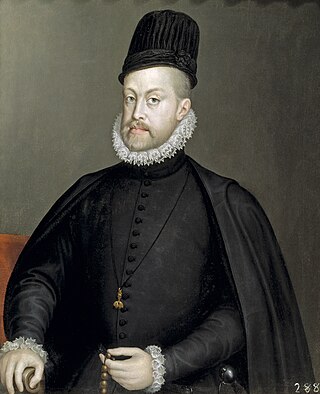
Philip II, sometimes known in Spain as Philip the Prudent, was King of Spain from 1556, King of Portugal from 1580, and King of Naples and Sicily from 1554 until his death in 1598. He was also jure uxoris King of England and Ireland from his marriage to Queen Mary I in 1554 until her death in 1558. Further, he was Duke of Milan from 1540. From 1555, he was Lord of the Seventeen Provinces of the Netherlands.
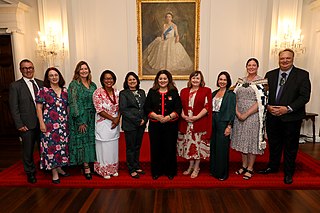
A viceroy is an official who reigns over a polity in the name of and as the representative of the monarch of the territory.

The Latin Union is an international organization of nations that use Romance languages, whose activities have been suspended since 2012. Headquartered in Paris, France, it aims to protect, project, and promote the common cultural heritage of Latin peoples and unifying identities of the Romance, and Romance-influenced, world. It was created in 1954 in Madrid, Spain. It started to operate in 1983 and its membership rose from 12 to 36 states, including countries in North America, South America, Northern Europe, Southern Europe, Africa, and the Asia-Pacific region.

The War of the Quadruple Alliance was fought from 1717 to 1720 by Spain and the Habsburg Monarchy, with the latter being joined in 1718 by Great Britain, France, and Savoy, and in 1719 by the Dutch Republic. Caused by Spanish attempts to recover territories in Italy ceded in the 1713 Peace of Utrecht, most of the fighting took place in Sicily and Spain, with minor engagements in North America. Spain also promoted the Jacobite rising of 1719 in Scotland in an effort to divert British naval resources.

The Casa de Contratación or Casa de la Contratación de las Indias was established by the Crown of Castile, in 1503 in the port of Seville as a crown agency for the Spanish Empire. It functioned until 1790, when it was abolished in a government reorganization.
A Real Audience, or simply an Audience, was an appellate court in Spain and its empire. The name of the institution literally translates as Royal Audience. The additional designation chancillería was applied to the appellate courts in early modern Spain. Each audiencia had oidores.

Minervino Murge is a town and comune, former bishopric and present Latin Catholic titular see in the administrative province of Barletta-Andria-Trani in the region of Apulia in southern Italy, lying on the western flank of the Murgia Barese mountain chain.

The Italian War of 1551–1559 began when Henry II of France declared war against Holy Roman Emperor Charles V with the intent of recapturing parts of Italy and ensuring French, rather than Habsburg, domination of European affairs. The war ended following the signing of the Treaty of Cateau-Cambrésis between the monarchs of Spain, England and France in 1559. Historians have emphasized the importance of gunpowder technology, new styles of fortification to resist cannon fire, and the increased professionalization of the soldiers.

The Council of the Indies, officially the Royal and Supreme Council of the Indies, was the most important administrative organ of the Spanish Empire for the Americas and those territories it governed, such as the Spanish East Indies. The crown held absolute power over the Indies and the Council of the Indies was the administrative and advisory body for those overseas realms. It was established in 1524 by Charles V to administer "the Indies", Spain's name for its territories. Such an administrative entity, on the conciliar model of the Council of Castile, was created following the Spanish conquest of the Aztec empire in 1521, which demonstrated the importance of the Americas. Originally an itinerary council that followed Charles V, it was subsequently established as an autonomous body with legislative, executive and judicial functions by Philip II of Spain and placed in Madrid in 1561.

Baltasar de Zúñiga y Guzmán, 1st Duke of Arión, 2nd Marquess of Valero was Spanish viceroy of New Spain from August 16, 1716, to October 14, 1722, and later president of the Council of the Indies.
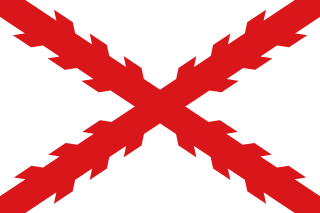
The New Kingdom of Granada, or Kingdom of the New Granada, was the name given to a group of 16th-century Spanish ultramarine provinces in northern South America governed by the president of the Royal Audience of Santafé, an area corresponding mainly to modern-day Colombia. The conquistadors originally organized it as a province with a Royal Audience within the Viceroyalty of Peru despite certain independence from it. The audiencia was established by the crown in 1549.
Events from the year 1622 in art.

The Real Audiencia of Quito was an administrative unit in the Spanish Empire which had political, military, and religious jurisdiction over territories that today include Ecuador, parts of northern Peru, parts of southern Colombia and parts of northern Brazil. It was created by Royal Decree on 29 August 1563 by Philip II of Spain in the city of Guadalajara. It ended in 1822 with the incorporation of the area into the Republic of Gran Colombia.
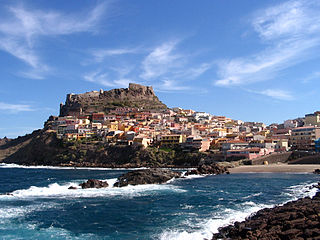
The Spanish conquest of Sardinia, also known as the Spanish expedition to Sardinia, took place between 22 August 1717 and 30 October 1717. It was the first military action between the Kingdom of Spain and the Holy Roman Empire after the War of the Spanish Succession (1701–1714), and was the direct cause of the War of the Quadruple Alliance (1718–1720). The Spanish troops commanded by the Marquis of Lede and Don José Carrillo de Albornoz, 1st Duke of Montemar, supported by the Spanish fleet, defeated the Emperor's troops easily, and conquered the entire island of Sardinia, which had been ruled by the Emperor since the Treaty of Rastatt (1714), returning it again and for the final time to Spain.
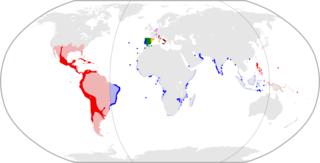
The Council of Italy, officially the Royal and Supreme Council of Italy, was a ruling body and key part of the government of the Spanish Empire in Europe, second only to the monarch himself. It was based in Madrid and administered the Spanish territories in Italy: the Kingdom of Naples, the Kingdom of Sicily, the Duchy of Milan, State of the Presidi, Marquisate of Finale and other minor territories.

From 1700 to 1720, the Kingdom of Sardinia, as a part of the Spanish empire, was disputed between two dynasties, the Habsburgs and the Bourbons. With the death of Charles II, the last of the Spanish Habsburgs, on 1 November 1700, the throne passed to Duke Philip of Anjou, although the Emperor Leopold I also had a claim. Leopold was especially desirous of obtaining the Spanish inheritance in the Southern Netherlands and in Italy, which included Sardinia. With the failure of France to abide by the Second Partition Treaty, the other European powers lined up on the side of the Habsburgs. The Treaty of the Hague allotted to the Emperor the Spanish possessions in Italy. Imperial troops invaded Italy to seize them, and the War of the Spanish Succession began.

Pedro Pacheco de Villena, also known as Pedro Pacheco Ladrón de Guevara, was a Spanish cardinal and viceroy of Naples. In Italian his name is spelled Pietro Pacecco. His nephew Francisco Pacheco de Toledo was also a cardinal.
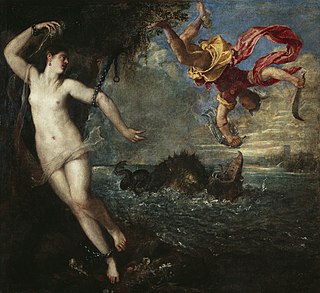
Perseus and Andromeda is a painting by the Italian Renaissance artist Titian, now in the Wallace Collection, in London. It was painted in 1554–1556 as part of a series of mythological paintings called "poesie" ("poetry") intended for King Philip II of Spain. The paintings took subjects from the Roman poet Ovid's Metamorphoses, in this case Book IV, lines 663–752, and all featured female nudes.

The Palau del Parlament de Catalunya is the seat of the Parliament of Catalonia, located in Barcelona. It was built between 1717 and 1727 as the arsenal of the Ciutadella, to the designs of Jorge Próspero de Verboom.